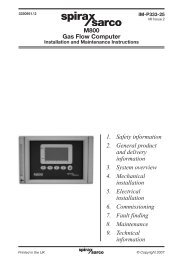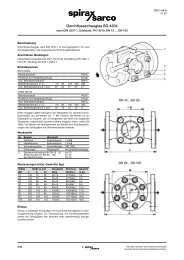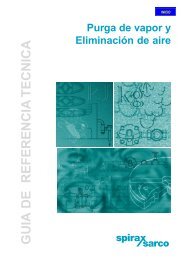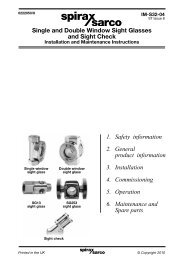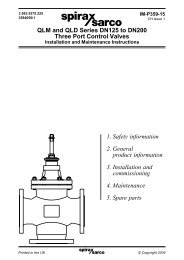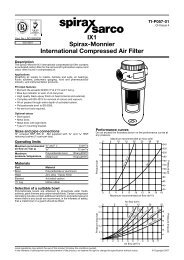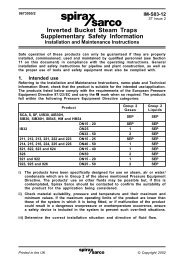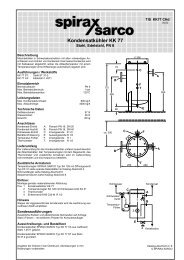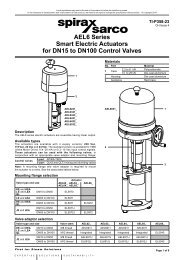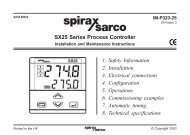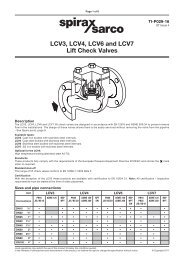2000 Hook-up Book - Spirax Sarco
2000 Hook-up Book - Spirax Sarco
2000 Hook-up Book - Spirax Sarco
Create successful ePaper yourself
Turn your PDF publications into a flip-book with our unique Google optimized e-Paper software.
SYSTEM DESIGN<br />
64<br />
Compressed Air Systems<br />
Table 20A: Pumped Circulation Water Storage Tanks<br />
Compressor Capacity, cfm free air 25 50 100 150 200 300 450 600 800<br />
Tank Capacity, gallons 50 100 180 270 440 550 850 1000 1200<br />
Table 20B: Ratio of Compression<br />
Gauge Pressure psi 10 20 30 40 50 60 70 80<br />
Ratio of Compression 1•68 2•36 3•04 3•72 4•40 5•08 5•76 6•44<br />
Gauge Pressure psi 90 100 110 120 130 140 150 200<br />
Ratio of Compression 7•12 7•8 8•48 9•16 9•84 10•52 11•2 14•6<br />
Table 21: Cooling Water Flow Rates<br />
Compressor operating at 100 psi<br />
Water Flow per<br />
100 cfm free air<br />
Single Stage 1.2 gpm<br />
Single Stage with Aftercooler 4.8 gpm<br />
Two Stage 2.4 gpm<br />
Two Stage with Aftercooler 6 gpm<br />
An air velocity of 20 to 30 ft/second<br />
or 1200 to 1800 ft/minute, is<br />
sufficiently low to avoid excessive<br />
pressure loss and to prevent reentrainment<br />
of precipitated<br />
moisture. In short branches to the<br />
air-using equipment, volocities <strong>up</strong><br />
to 60-80 ft/second or 3600-4800<br />
ft/minute are often acceptable.<br />
Checking Leakage Losses<br />
Air line leaks both waste valuable<br />
air and also contribute to pressure<br />
loss in mains by adding useless<br />
load to compressors and mains.<br />
Hand operated drain valves are a<br />
common source of leakage that<br />
can be stopped by using reliable<br />
automatic drain traps. Here is a<br />
simple way of making a rough<br />
check of leakage loss. First, estimate<br />
the total volume of system<br />
from the receiver stop valve to the<br />
tools, including all branches, separators,<br />
etc. Then with no<br />
equipment in use, close the stop<br />
valve and with a stop watch note<br />
the time taken for the pressure in<br />
the system to drop by 15 psi. The<br />
leakage loss per minute is:<br />
Cu. ft. of Free Air<br />
Loss per Minute<br />
=<br />
Volume of System Cu. Ft.<br />
Time in Minutes to Drop<br />
Pressure 15 psi<br />
Compressor Cooling<br />
Air cooled compressors, formerly<br />
available only in the smaller sizes,<br />
are now found with capacities <strong>up</strong><br />
to 750 cfm, and rated for pressures<br />
<strong>up</strong> to 200 psi. The cylinders<br />
are finned and extra cooling is provided<br />
by arranging the flywheel or<br />
a fan to direct a stream of air on to<br />
the cylinder. Such compressors<br />
should not be located in a confined<br />
space where ambient air<br />
temperatures may rise and prevent<br />
adequate cooling.<br />
Water cooled compressors<br />
have water jackets around the<br />
cylinders, and cooling water is circulated<br />
through the jackets.<br />
Overcooling is wasteful and costly,<br />
and can lead to corrosion and<br />
wear within the compressor.<br />
Temperature control of the cooling<br />
water is important.<br />
Pumped Circulation<br />
Larger single-staged compressors<br />
may require a pump to<br />
increase the water velocity when<br />
thermo-siphon circulation is too<br />
slow. The size of the water tank<br />
should be discussed with the<br />
compressor manufacturer, but in<br />
the absence of information, Table<br />
20A can be used as a guide for<br />
compressors operating at <strong>up</strong> to<br />
100 psi.<br />
Single Pass Cooling<br />
The hook-<strong>up</strong> shown in Fig. II-103<br />
(page 135) is used where water<br />
from the local s<strong>up</strong>ply is passed<br />
directly through the compressor<br />
to be cooled. With increasing<br />
demands on limited water<br />
resources, many water s<strong>up</strong>ply<br />
authorities do not permit use of<br />
water in this way, especially<br />
where the warmed water is discharged<br />
to waste, and require the<br />
use of recirculation systems.<br />
When single pass cooling is<br />
used, temperature controls will<br />
help ensure consumption is minimized.<br />
To avoid the sensor control<br />
being in a dead pocket if the control<br />
valve ever closes, a small<br />
bleed valve is arranged to bypass<br />
the control valve. This ensures a<br />
small flow past the sensor at all<br />
times.<br />
Many compressor manufacturers<br />
suggest that the temperature of<br />
the water leaving the cylinder jackets<br />
should be in the range of<br />
95-120°F. Typical water flow rates<br />
needed for compressors are shown<br />
in Table 21, but again, these should<br />
be checked with the manufacturer<br />
where possible.<br />
The s<strong>up</strong>ply of cooling water can<br />
sometimes be taken from the softened<br />
boiler feed water storage<br />
tank. The warmed outlet water then<br />
becomes a source of pre-heated<br />
make<strong>up</strong> water for the boiler.



